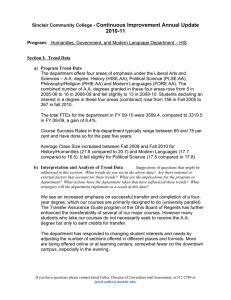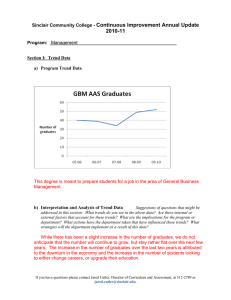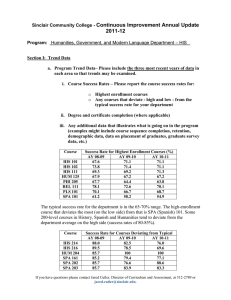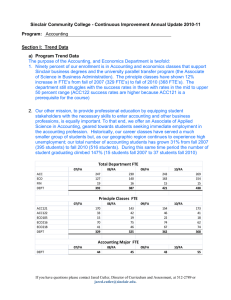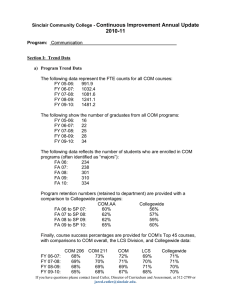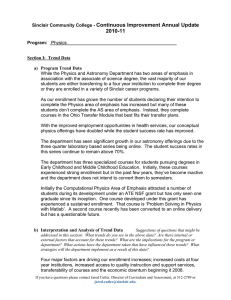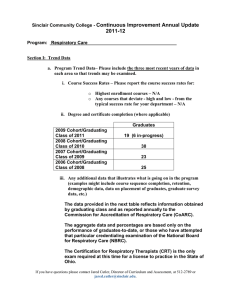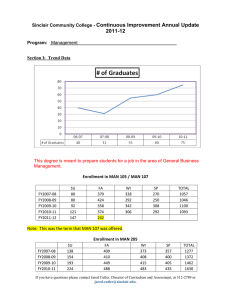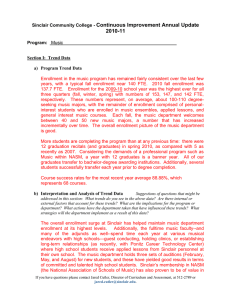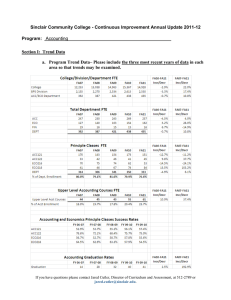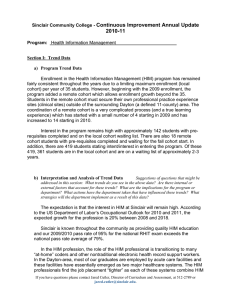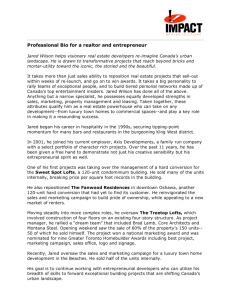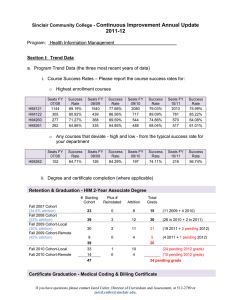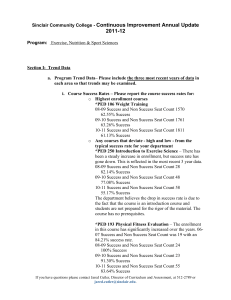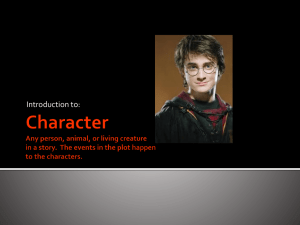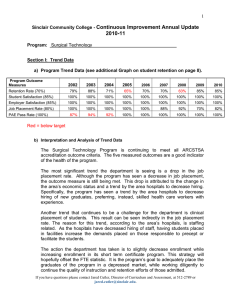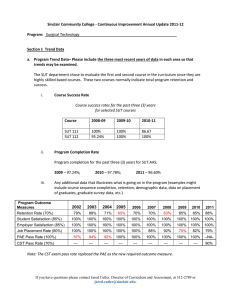Continuous Improvement Annual Update 2010-11
advertisement
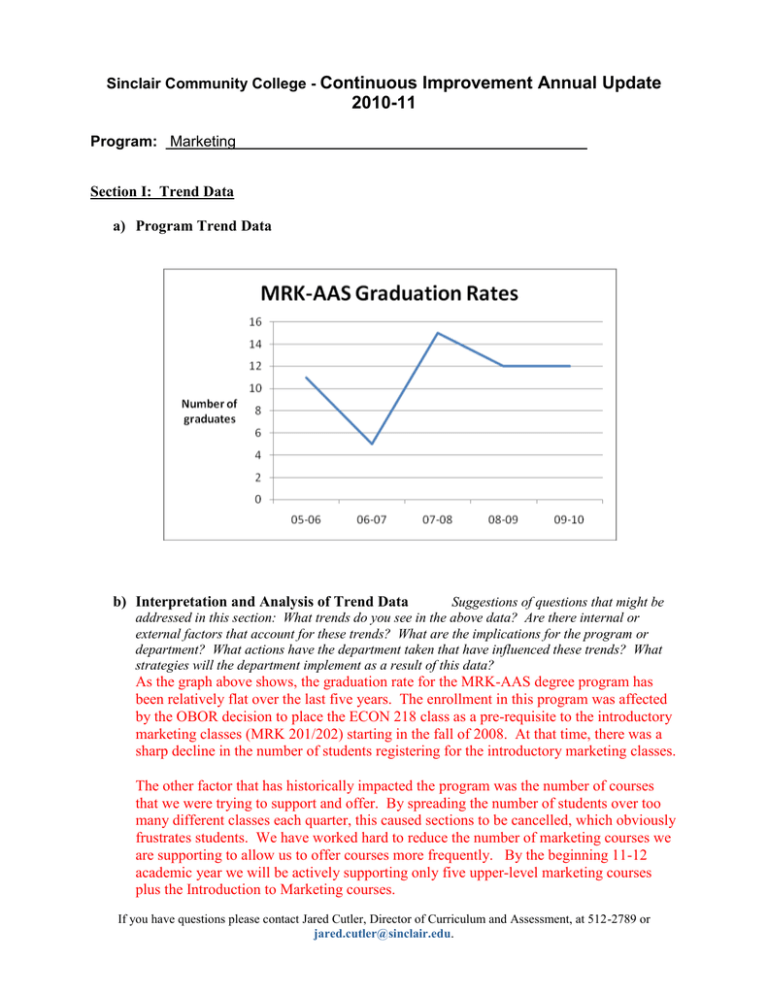
Sinclair Community College - Continuous Improvement Annual Update 2010-11 Program: Marketing Section I: Trend Data a) Program Trend Data b) Interpretation and Analysis of Trend Data Suggestions of questions that might be addressed in this section: What trends do you see in the above data? Are there internal or external factors that account for these trends? What are the implications for the program or department? What actions have the department taken that have influenced these trends? What strategies will the department implement as a result of this data? As the graph above shows, the graduation rate for the MRK-AAS degree program has been relatively flat over the last five years. The enrollment in this program was affected by the OBOR decision to place the ECON 218 class as a pre-requisite to the introductory marketing classes (MRK 201/202) starting in the fall of 2008. At that time, there was a sharp decline in the number of students registering for the introductory marketing classes. The other factor that has historically impacted the program was the number of courses that we were trying to support and offer. By spreading the number of students over too many different classes each quarter, this caused sections to be cancelled, which obviously frustrates students. We have worked hard to reduce the number of marketing courses we are supporting to allow us to offer courses more frequently. By the beginning 11-12 academic year we will be actively supporting only five upper-level marketing courses plus the Introduction to Marketing courses. If you have questions please contact Jared Cutler, Director of Curriculum and Assessment, at 512-2789 or jared.cutler@sinclair.edu. Because of the declining enrollment in the program, and the realization from out advisory board that the options for a graduate with an AAS degree in Marketing were very limited, we have decided to deactivate the MRK-AAS degree program effective in the fall of 2012. We will still offer a certificate program in marketing. Section II: Progress Since the Most Recent Review a) What was the fiscal year of the most recent Program Review for this program? 2005-06 b) Briefly summarize the goals that were listed in Section IV part E of the most recent Program Review Self-Study (this section of the Self-Study asks “What are the department’s/program’s goals and rationale for expanding and improving student learning, including new courses, programs, delivery formats and locations”)? As faculty within the Marketing and Management department, we challenge ourselves to demonstrate, through words and actions, how one manages time, events, people, resources and markets products and services in our fast-based, changing global economy. In a true sense, we want to provide student learning through, and by, example. We understand, as a faculty, the fragile nature of many of our students and we strive to provide not only academic improvement but improvement in self-esteem, maturity and organizational savvy. To this end, we look for technologies, pedagogies, resources and methods that will provide the student with the learning they need and deserve. This requires an almost continual scanning of our environment and communication with our stakeholders to ensure new methods are considered, piloted, and adopted. To this end, our faculty serve on many external boards and committees, update their skills through seminars/workshops and practice business skills through many avenues within the community. c) Have these goals changed since your last Program Review Self-Study? If so, please describe the changes. These goals have not changed since the last Program Review Self-Study. d) What progress has been made toward meeting any of the goals listed above in the past year? We realized a major issue we had as a department was that we did not have the right people on our advisory board. Two years ago we began the process of finding the right people and we revamped the board. We now believe we have the right people, with the right skills on board. The first order of business with the new board was to revisit our program outcomes. The board recommended major changes to the outcomes based on the needs of employers in today’s job market. As a result, we have completely rewritten the program outcomes based on the input of the advisory board. With this new direction, we then focused on the course outcomes as we started through the semester conversion process. If you have questions please contact Jared Cutler, Director of Curriculum and Assessment, at 512-2789 or jared.cutler@sinclair.edu. During this process we looked at the technologies, pedagogies, resources and methods that were being used in the classroom. All courses now have a variety of these tools that all full-time and adjunct faculty have at their disposal when teaching any of the classes within Marketing. e) What Recommendations for Action were made by the review team to the most recent Program Review? What progress has been made towards meeting these recommendations in the past year? Use advisory committee more extensively to inform, guide, and validate program improvements As stated above, the advisory board was revamped to get the right people, with the right skills, sitting in the right seats. We now have a very active and energized advisory board that clearly understands what we are trying to do, and how they can help us get there. During the last year, we completely revised the program outcomes and have filtered those down to the course level through the semester conversion process. Continue to improve departmental professional development for part-time faculty members and potential faculty members (e.g., recent retirees) We have held several training sessions for our adjunct faculty members including training sessions on the ANGEL grade book and attendance manager, the new program outcomes and how they tie back to course outcomes, classroom expectations, etc. We now require the adjunct certification course for all new adjuncts, as well as on-line certification for anyone teaching on-line classes. Additionally, several of the full-time faculty completed these courses as well. Shift the assessment of program outcomes from knowledge based to application, incorporating other higher order thinking skills Our marketing capstone course, which is now MRK 220, serves as the central course where program outcomes are assessed. MRK 220 is an integrative course where students work collaboratively to develop a marketing plan for an actual business. Assessment of our program is centered around the output of this project based on a panel evaluating the reports and presentations using a rubric. Section III: Assessment of Outcomes The Program Outcomes for this program are listed below. At least one-third of your program outcomes must be assessed as part of this Annual Update, and across the next three years all of these program outcomes must be assessed at least once. In which Which of these program Assessment courses are outcomes were assessed Methods these program during the last fiscal Used Marketing Program Outcomes outcomes year? addressed? If you have questions please contact Jared Cutler, Director of Curriculum and Assessment, at 512-2789 or jared.cutler@sinclair.edu. 1) Describe basic marketing principles and terminology and illustrate the role of marketing in an organization and its importance in the strategic planning process. MRK 2101, MRK 220 MRK 220 2) Apply the marketing strategy process and be able to participate in the development of marketing strategies and tactics. 3) Skill in creative and critical thinking, written and oral communication, and ethical reasoning MRK 220 Final written project grades (scored via a rubric) written and oral rubrics a) For the assessment methods listed in the table above, what were the results? What changes are planned as a result of the data? How will you determine whether those changes had an impact? Outcome #2 - Final written project grades (scored via a rubric) from the marketing capstone course are used to track this outcome. Results are as follows: WI10 – 80% class average FA10 – 83.6% class average Improvement Areas Identified in WI10: The sample size for this class is small. 12 students were enrolled in WI10 and only 5 in FA10. So, meaningful analysis is difficult. The issues or areas targeted for improvement from WI10 to FA10 were 1) better analysis of target markets and segmentation strategies and 2) development of more creative and cost effective recommendation that are appropriate for all business sizes. Improvement Strategy and Findings: Issue #1) A segmentation and target market video was introduced in the fall of 2010 to help assist with target market analysis. While this video was helpful, more needs to be done here. An assignment is going to be created this spring to offer further exploration of this topic. Issue #2) Several assignments surrounding guerrilla-marketing tactics, including a YouTube assignment to explore the book Guerrilla Marketing, were introduced to address area #2. Cost effectiveness of recommendations improved as a result. These assignments will be continued in the spring 2011 quarter. Outcome #3 - The written and oral rubrics from the capstone course are used to track this outcome. The relevant areas of the rubric used to measure the written communication component of the general education outcome are a) sources cited, b) grammar/spelling/punctuation, c) organization, and d) key information obtained. For the oral communication competency, overall oral presentation scores are used (as measured by an oral presentation rubric). Results are as follows: Written Communication (as measured by rubric for areas cited above) WI10: 6.75 out of 10 for class average FA10: 6.44 out of 10 for class average Improvement Areas Identified in WI10 Issue #1) Written communication skills, including basic spelling, grammar, punctuation, sentence structure, have continually been an area that needs to be addressed. If you have questions please contact Jared Cutler, Director of Curriculum and Assessment, at 512-2789 or jared.cutler@sinclair.edu. Issue #2) Student knowledge of how to do advanced and in-depth research by utilizing other means than “Google” to obtain key information was another area identified for improvement. Improvement Strategy and Findings: Issue #1) A writing center staff member was brought to class to discuss the writing center purpose, resources available, and location. Students were encouraged to visit when developing their rough drafts and final papers. Because the class size was small in the fall with only 5 students, meaningful analysis of how well this worked is difficult. Two out of the five students had noticeable deficiencies and skewed the average. This strategy will be continued this spring and monitored for additional ways to improve outcome. Issue #2) A library staff member was brought in to discuss and demonstrate library resources to aid in elevating the depth of research completed. This did raise quality of research and will be continued. Oral Communication (as measured by overall oral presentation rubric score) WI10: 87% for class average FA10: 83.4% for class average Improvement Areas Identified in WI10 This area was not targeted for improvement in WI10. The average dropped slightly in the fall, but again, with such a small sample size this is not statistically significant. b) What other changes have been made in past years as a result of assessment of program outcomes? What evidence is there that these changes have had an impact? We have shifted our focus away from offering courses that are more theory based to courses that are more skills-based. We are discontinuing Consumer Behavior effective fall 2011 and replacing it with Digital Marketing. With the growing demand for employees who understand and can immediately contribute to digital marketing efforts we feel that these types of courses will fit well into the certificate program. c) Describe general education changes/improvements in your program/department during this past academic year (09-10). Outcome #3 above details the general education changes/improvements made within the MRK-AAS program during the last academic year. Section IV: Improvement Efforts for the Fiscal Year a)FY 09-10: What other improvement efforts did the department make in FY 09-10? How successful were these efforts? What further efforts need to be made? If your department didn’t make improvement efforts during the fiscal year, discuss the strengths If you have questions please contact Jared Cutler, Director of Curriculum and Assessment, at 512-2789 or jared.cutler@sinclair.edu. and weaknesses of the department over the last year and how the department plans to address them in the coming year. The department has worked closely with full-time faculty, adjuncts, and academic advisors to ensure that students understand the difference between the Business AS and AAS degrees. This was identified as an area for action from the 08-09 Program Review. During the adjunct training sessions that were held during the last year, we have stressed the difference between the two degree programs, and have requested that the information be shared with students during the initial class session of each quarter for the lower level classes. The department has also worked closely with the Tech Prep office to not only develop clear pathways for transfer to four year institutions, but also to increase the success rate of students in the Tech Prep program. IT is too early to tell how successful this effort has been, but we are continuing to monitor the progress and make changes as needed. A real strength of the department is the faculty team. We have a strong group of dedicated individuals that are committed to continuously improving the program to provide our students with the best education possible. During this timeframe, the entire degree program was put on-line, giving our students more options to complete their degree and to be successful. b)FY 10-11: What improvement efforts does the department have planned for FY 10-11? How will you know whether you have been successful? We will continue to evaluate when courses are offered and how often they are offered to ensure that students can complete the degree as easily as possible. We will also continue to work with adjuncts to facilitate active learning approaches and complete an in-class observations of all adjuncts by the end of the year. Finally, we will continue to incorporate the latest trends such as social media into curriculum and assignments. Questions regarding completion of the Annual Update? Please contact the Director of Curriculum and Assessment at 512-2789 to schedule a time to review the template and ask any questions. If you have questions please contact Jared Cutler, Director of Curriculum and Assessment, at 512-2789 or jared.cutler@sinclair.edu.
